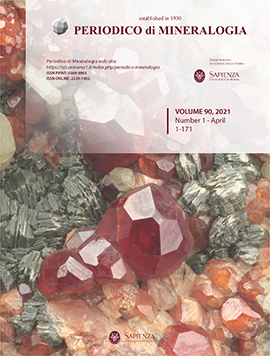Mineralogy and elemental composition of urinary stones: a preliminary study in northwest of Iran
DOI:
https://doi.org/10.13133/2239-1002/16764Keywords:
Mineralogy, Environmental geology, Urinary stones, Calcium oxalate, Water quality.Abstract
The Formation of Urinary Calculi [or Kidney stones (renal lithiasis, nephrolithiasis)] is a serious disease among Iran’s population, inasmuch as renal stone prevalence rate is annually about 145 cases per 100000 men and women. In this study, the mineralogy and elemental composition of urinary stones were studied in East Azerbaijan province, located in northwest of Iran. X-ray diffraction (XRD), X-ray fluorescence (XRF) and atomic absorption spectroscopy (AAS) analyses were used to investigate the mineralogy of different types of Urinary Calculi. The results showed that the collected Urinary Calculi samples can be divided into four groups, based on their mineralogical aspect: mono-hydrated calcium oxalate, di-hydrated calcium oxalate, uric acid and urate/calcium oxalate/cystine, in which whewellite and uricite were the most abundant mineral phases. The oxalate stone types were characterized by the high concentrations of zinc, phosphorus and magnesium. Common minerals in the studied renal stones indicated that calcium oxalate urinary stones have a similar prevalence ratio as in Middle East countries. However, urate compounds were significantly higher in Iran compared to other countries; The niahite mineral was not found in studied samples. In the cities having very hard and hard drinking water, uric acid and oxalate type stone were the main phases in East Azerbaijan province with Mediterranean climate, urate urinary stones were dominant. XRF results indicated that the frequency of Ca was from 0.11 to 25.63%, which has the highest concentration among other elements. The strong positive correlation between Ca and P indicated that calcium tends to be participated in the structure of phosphorus–bearing urinary stones.


